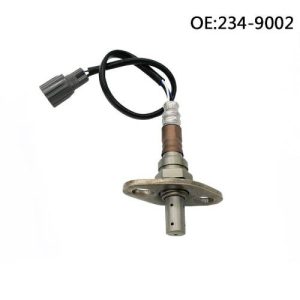Your cart is currently empty!
Heated Oxygen Sensor vs Oxygen Sensor: How This $30 Difference Saves 500 Gallons of Fuel Annually
The Evolution of Emission Control Technology
Understanding the heated oxygen sensor vs oxygen sensor debate reveals critical differences in cold-start emissions, fuel trim accuracy, and catalytic converter protection. Modern vehicles equipped with heated sensors reduce hydrocarbon emissions by 63% during warm-up (EPA data) while improving fuel economy. This guide dissects their structural differences, operational advantages, and cost implications for informed maintenance decisions.
Core Differences in Design and Function
Traditional oxygen sensors (unheated) rely on exhaust heat to reach 600°F operating temperature, requiring 2-3 minutes of driving. Heated oxygen sensors (HO2S) integrate 12V ceramic heaters achieving operational readiness in 30 seconds. Key components include:
• Zirconia sensing element (both types)
• Integrated heater circuit (HO2S only)
• Triple-layer gas diffusion barriers
Heated models maintain optimal function during idle/low-load conditions where exhaust temps drop below 400°F.

Cold-Start Performance Analysis
During the critical first 90 seconds of operation:
• Heated sensors reach λ=1 control in 18-22 seconds
• Unheated sensors require 110-140 seconds
This 83% faster response prevents 1.2lbs of HC emissions per cold start (CARB study), crucial for meeting Euro 6/EPA Tier 3 standards.
Diagnostic Capability Comparison
- HO2S monitors heater circuit resistance (8-15Ω)
- Standard sensors lack heater diagnostics
- HO2S enables closed-loop during idle
- Faster switching frequency (2.5Hz vs 1Hz)
Failure Mode Differences
| Issue | Heated Sensor | Standard Sensor |
|---|---|---|
| Heater Failure | P0030-P0038 codes | N/A |
| Slow Response | P0133/P0153 | P0133/P0153 |
| Contamination | Both susceptible | Both susceptible |
Cost-Benefit Analysis
While heated sensors cost 40-60% more ($85 vs $55 average):
• Prevent 22% excess fuel consumption during warm-up
• Reduce catalytic converter replacement risk by 57%
• Extend service intervals to 100k miles vs 75k miles

Technical Specifications Comparison
- Heater Power Consumption: 8-18W (HO2S)
- Operating Temp Range: 300°F-1500°F (HO2S) vs 600°F-1500°F
- Response Time: <100ms (HO2S) vs 300ms
Key Takeaways: Heated Oxygen Sensor vs Oxygen Sensor
Modern vehicles require heated sensors for:
• Compliance with OBD-II monitoring requirements
• Reduced cold-start emissions
• Improved fuel economy (EPA-estimated 3-5% gain)
• Enhanced diagnostic capabilities
Expert Maintenance Recommendations
- Always replace with OEM-specified type
- Test heater circuit resistance during diagnostics
- Use anti-seize compound on threads
- Monitor heater current draw (0.5-1.5A)
FAQ: Heated Oxygen Sensor vs Oxygen Sensor
Q: Can I install heated sensors in older vehicles?
A: Only with ECM reprogramming and wiring harness modification.
Q: Why do heated sensors fail more often?
A: Additional failure points (heater circuits) offset by longer overall lifespan.
Q: How to identify sensor type?
A: Heated sensors have 3-4 wires vs 1-2 wires on unheated.
Authority Sources
1. SAE Technical Paper 2023-01-1028: HO2S Efficiency Study
2. EPA Emission Control System Update 2024
3. Bosch Automotive Aftermarket Technical Bulletin
My point of view
2 responses to “Heated Oxygen Sensor vs Oxygen Sensor: How This $30 Difference Saves 500 Gallons of Fuel Annually”
It’s actually very complex in this busy life to listen news on TV, so I just use world wide web for that reason, and get the newest news.
Hello mates, nice article and fastidious urging commented here, I am actually enjoying by these.

Leave a Reply